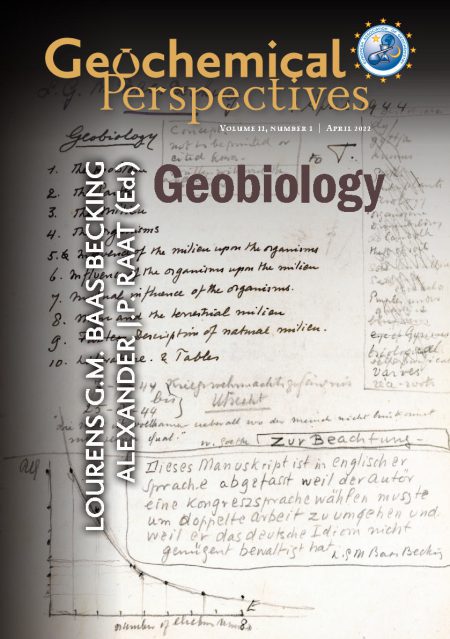
Geobiology
by Lourens G.M. Baas Becking and Alexander J.P. Raat (Ed.)doi: 10.7185/geochempersp.11.1 | Volume 11, Number 1 (pages 1-168)
Please note that this issue is longer than our usual format and includes extensive footnotes. It is therefore published online only; no printed version is made available. However, in this online format, all footnotes can easily be accessed from the text.
PDF version: to view all footnotes as pop-up windows, please download and open the file in a PDF reader (e.g. Adobe Acrobat). Simply move your mouse on top of a footnote number in the text to view the content of the footnote (in case a window already appears opened, just click on the number of the footnote in the text to close it).
Abstract
Lourens Baas Becking (1895-1963) was a Dutch plant physiologist, trained in the Botanical Laboratory of Utrecht University. After graduating in 1919, he worked in America at Stanford University, where he obtained his Doctor’s degree in 1921. From 1928, he was Herzstein Professor of Biology and Director of the Jacques Loeb Physiological Laboratory at the Hopkins Marine Station in Palo Alto. In 1931, he became Professor of General Botany at the University of Leiden. There, he and his staff and students continued to work on the research of microorganisms under extreme saline conditions. In 1939, he was appointed Director of the institutes of the Botanic Garden at Buitenzorg (Bogor) in the Dutch East Indies (Indonesia). In May 1940, when the war broke out, he was in Leiden to retire from his professorship. The war prevented his return to his family and the institutes in the East Indies. Baas Becking made several failed attempts to escape to England. These resulted in imprisonments by the German occupying authorities in Scheveningen (1940-1941) and in Utrecht and the German Zuchthaus in Siegburg (1944-1945). An ordeal that he barely survived due to the inhuman situation in the penitentiary and typhus.
In July and August 1944, as a prisoner of the German Kriegsmarine in Utrecht, he wrote in seven weeks a manuscript of Geobiology, an essay on the relationship between living organisms and the earth. It was an update of his earlier ideas. Baas Becking had been inspired by Lawrence Henderson’s The Fitness of the Environment (1913), Victor Moritz Goldschmidt’s Der Stoffwechsel der Erde (1922) and Grundlagen der quantitativen Geochemie (1933), Alfred J. Lotka’s Elements of Physical Biology (1924) and Vladimir Vernadsky’s La Géochimie (1924). They were with Frank W. Clarke’s The Data of Geochemistry (1916), sources for his perception of The Universality of Life in 1927, which integrated Vernadsky’s concepts of biosphere and geosphere. Long before James Lovelock and Lynn Margulis defined the Gaia hypothesis in the early 1970s, Baas Becking discussed Gaia or Life and Earth in his inaugural address in 1931. In this tract he also succinctly summarised the ubiquity hypothesis, borrowed from the work of Martinus Beijerinck, as “Everything is everywhere, but the Milieu selects.” The biological “law” was further elaborated in Geobiologie of inleiding tot de milieukunde (1934, English version 2016, Baas Becking’s Geobiology).
In the Utrecht prison Baas Becking wrote his scientific testament. In the ten years since the publication of Geobiologie, he “wished to do justice to the work that was performed in Leiden by so many workers”, in an English textbook. With a limited access to scientific literature, he wrote the manuscript Geobiology in a ledger in a barely legible handwriting. The document reflected his vast biological knowledge and his idea of mutual dependence of vital-units (cells, tissues, organs, organism, communities), either of a parasitic, mutualistic or commensalistic character. This relationship was elaborated in his model of symbiosis. His description of the role of man in Geobiology is a personal complaint of a geobiologist over the disastrous treatment of the earth by man. With his concept of “dissipation”, he introduced a material analogue for “the entropy lowering capacity of living systems”. It summarised his conviction that the human intellect and life condition were attributes of free will. Although Geobiology (1944) remained unfinished and had major gaps, it still is an inspiring memoir of a scientist who records his enlightened vision on the relationship between life and earth.
In this issue of Geochemical Perspectives the manuscript of Geobiology is integrally transcribed, annotated, edited and introduced by Dr. Alexander J.P. Raat, who graduated in 1974 in Leiden as a plant physiologist. The transcript is published with the original illustrations. A sketch of Baas Becking’s life and works is part of the introduction. The annotation and introduction refer to many of his published and unpublished studies. Among these is an unpublished, further updated and revised version of Geobiology, which he completed in 1953 in Australia.

